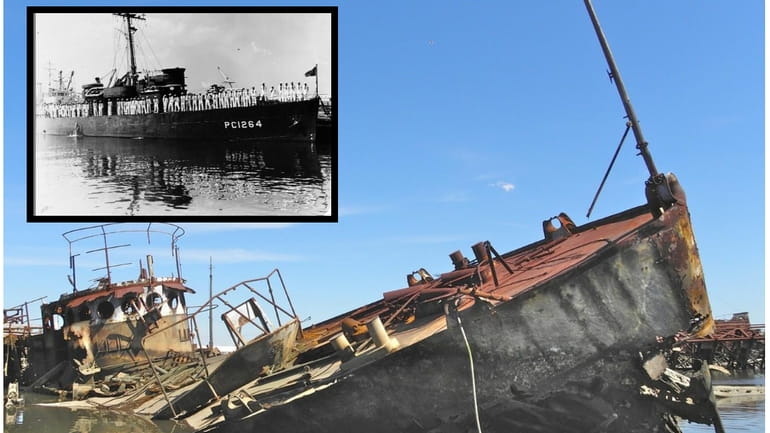Remembering the Black sailors of WW II

The USS PC-1264, a historic World War II subchaser, continues its slow disintegration off Staten Island. Inset: The officers and crew of the PC-1264 line its deck in a photograph from 1944. Credit: Will Van Dorp, U.S. Naval History and Heritage Command Photograph
Sitting in the silt, not far from the Statue of Liberty, within the backwaters of the Arthur Kill, is a slowly decaying tribute to African American sailors of World War II.
The vessel is a patrol class of submarine chaser considered too small and among too many to be christened with a name by the U.S. Navy. This particular ship, the PC-1264, would make a major impact and contribution to confronting racial bigotry in America and prejudice within our armed forces by being manned by an all-Black crew by the end of the conflict.
Disregarded by many as a ship mainly consisting of stewards fit to serve the officers their meals and little more, this 173-foot-long subchaser would make waves by being the first to promote and deploy Black petty officers, and setting a record for the speed with which depth charges rolled off the vessel in search of deadly U-boats.
In addition, Samuel L. Gravely Jr. of Richmond, Virginia, an ensign in charge of the communications section and the sole Black officer of the ship while serving alongside his white counterparts, went on to become the first African American to reach the rank of admiral, retiring as a vice admiral.
The PC-1264 was a floating test bed for skeptical naval leadership to determine whether or not Blacks had the skill and fortitude to fight and defeat a ruthless submarine enemy that torpedoed countless Allied convoys, as opposed to serving coffee, eggs and bacon to officers in the mess hall. She and her crew would do all this and more, from helping to thwart a last ditch threat by the German Navy to fire “V-1 buzz bombs” from their infamous U-boats, to escorting a French submarine through the potential hazards of friendly fire from Allied naval forces.
While carrying out her wartime duty of patrolling the U.S. Eastern Seaboard, the PC-1264 put to rest misconceptions, doubts, and racial ridicule aimed at Black sailors. While pursuing the enemy, the crew not only confronted institutional prejudice but defeated it, becoming part of the unstoppable forces that eventual ensured inclusion of all Americans into the ranks of our armed forces. She reminded the powers that be in the Navy, and in the White House, that civil rights would need to be addressed once and for all in postwar America.
At a time when the men who broke the color barrier in the air, the Tuskegee Airmen, are appropriately remembered, and historians call attention to the African American GIs of World War II, the PC-1264 continues its slow, unnoticed disintegration off Staten Island. It stands as a mute hulk, but it continues to stand guard, confronting the prejudices of the past and the bigotry of the present. Her identity has been stricken from the Navy's registry, her commissioning pennant returned to her former employer, but she has remained upright, withstanding the elements for eight decades, refusing to die.
The ship’s historic importance is gaining recognition. Army veteran and Babylon Town Councilman DuWayne Gregory and the Old Bethpage-based Museum of American Armor are among those who have joined a committee that seeks to pay tribute to the ship and the men who sailed her. While refloating and restoring the vessel is problematic, nothing is impossible; the PC-1264 deserves a second chance.
Regardless of its physical fate, its legacy needs to be introduced into the curriculum of Black History Month as a chapter that made a profound and lasting difference in who we are as a nation and the voyage we still need to navigate.
This guest essay reflects the views of Nick Casseus, an Amityville resident and founder of Friends of PC-1264.
